
Sunday 31 October 2010
Saturday 30 October 2010
Pannage


 The cycle of the forest year keeps turning and once again we're in the middle of pannage. Pannage or ‘common of mast’ is one of the common rights attached to various New Forest holdings which allows commoners to graze their pigs on fallen acorns, which are poisonous to ponies and cattle; the pigs also eat beech mast and crab apples, all of which carpet the woodland floors in a good season. Traditionally pannage allowed commoners the opportunity to fatten their pigs in preparation for slaughter for use during the winter. In the 1800's more than 6000 pigs roamed the woods, over the years numbers have declined to no more than 600, although they appear to have increased in number of the last few years. The pigs come in all sizes, from large Saddlebacks to groups of piglets; usually nonchalant to our presence, a mother can become defencive if she beleives her young are in danger...and they can more!
The cycle of the forest year keeps turning and once again we're in the middle of pannage. Pannage or ‘common of mast’ is one of the common rights attached to various New Forest holdings which allows commoners to graze their pigs on fallen acorns, which are poisonous to ponies and cattle; the pigs also eat beech mast and crab apples, all of which carpet the woodland floors in a good season. Traditionally pannage allowed commoners the opportunity to fatten their pigs in preparation for slaughter for use during the winter. In the 1800's more than 6000 pigs roamed the woods, over the years numbers have declined to no more than 600, although they appear to have increased in number of the last few years. The pigs come in all sizes, from large Saddlebacks to groups of piglets; usually nonchalant to our presence, a mother can become defencive if she beleives her young are in danger...and they can more!Friday 29 October 2010
Latchmore Bottom
 Nestled amongst the wet bog and heathland filling Latchmore Bottom are the remains of an out laying marker associated with the nearby Ashley Ranges. The feature consists of 15, square , shuttered concrete light housings, of which only 13 remain visible and of those only one of which retains its internal light fittings. The concrete housings are 46cm square, 28cm high (external), 20cm (internal), with 7.5cm thick walls and two 10cm diameter pipe holes for connecting cables and are placed in a circle of chalk 25m in diameter. There must be some associated features nearby as this feature's so far out it surely required an independent power supply; adjacent there is a Holly covered knoll which may bear investigation.
Nestled amongst the wet bog and heathland filling Latchmore Bottom are the remains of an out laying marker associated with the nearby Ashley Ranges. The feature consists of 15, square , shuttered concrete light housings, of which only 13 remain visible and of those only one of which retains its internal light fittings. The concrete housings are 46cm square, 28cm high (external), 20cm (internal), with 7.5cm thick walls and two 10cm diameter pipe holes for connecting cables and are placed in a circle of chalk 25m in diameter. There must be some associated features nearby as this feature's so far out it surely required an independent power supply; adjacent there is a Holly covered knoll which may bear investigation.Thursday 28 October 2010
Wednesday 27 October 2010
Stonard Wood
 High on the edge of Stoney Cross Plain, Stonard Wood enjoys views across swathes of open heathland, plantation and ancient deciduous woodland, bonded to the land through hundreds of years of tenure. A twisted mature Oak, overlooking Withybed Bottom and Lucas Castle, bears testament to both the powerful elemental forces of nature and the endurance and strength of the mighty Oak. The twisted wooden Leviathan appears to have been contorted by unseen forces, all its outstretched boughs wrenched through over 90 degrees and down before resting, bracing itself on the ground. The age and nature of this tree suggests these events happened many year ago. Bowed, but not beaten, the Oak persists and thrives.
High on the edge of Stoney Cross Plain, Stonard Wood enjoys views across swathes of open heathland, plantation and ancient deciduous woodland, bonded to the land through hundreds of years of tenure. A twisted mature Oak, overlooking Withybed Bottom and Lucas Castle, bears testament to both the powerful elemental forces of nature and the endurance and strength of the mighty Oak. The twisted wooden Leviathan appears to have been contorted by unseen forces, all its outstretched boughs wrenched through over 90 degrees and down before resting, bracing itself on the ground. The age and nature of this tree suggests these events happened many year ago. Bowed, but not beaten, the Oak persists and thrives.Tuesday 26 October 2010
Grey
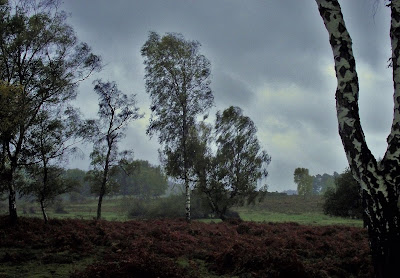 The forest is grey and damp, rain, carried on brisk winds which strain the younger trees, lashes the land; stronger gusts of wind ruffle the fading ferns and create a cacophony of sound and motion amongst the older stands. Through Vinney Ridge the surface of Black Water, now flowing with renewed vigor, is peppered with the sploosh sploosh of large drops falling through the canopy. Dampness is the theme of the day.
The forest is grey and damp, rain, carried on brisk winds which strain the younger trees, lashes the land; stronger gusts of wind ruffle the fading ferns and create a cacophony of sound and motion amongst the older stands. Through Vinney Ridge the surface of Black Water, now flowing with renewed vigor, is peppered with the sploosh sploosh of large drops falling through the canopy. Dampness is the theme of the day.Monday 25 October 2010
South Oakley

Walking through a recently cleared block of South Oakley Enclosure (1853), it strikes me, stood in the late afternoon Sun, that the newly exposed ground below, so long in the shade, is once again experiencing the warmth of sunlight; I well remember this dank path , now transformed. Until recently stands of tall, straight, mature Spruce of some variety stood abouts; relatively recent replacements for formally cleared 1853 Oaks and Beech, now too, gone. The forest is always changing, developing, adapting. They're changing the woodland here by trimming out some of the earlier deciduous woodland, creating lighter, more open spaces, whilst sections of fence are being removed or rerouted unenclosing areas of old woodland. Although even with stock fencing removed, the earlier 1853 boundary remains clearly visible as the linear low broad bank and shallow ditch, earthen demarcation intended. The opening up of the wood will positively impact on woodland species, creating new habitats, new possibilities and niche environments. For now the woodland grows increasingly quiet. As the Sun sinks slowly below Vereley Wood on the horizon, so does the temperature and the forest falls silent.
Sunday 24 October 2010
Ford Oak
 Adjacent a ford on the upper reaches of Highland Water a majestic Oak stands proud, its age, 300 years or so, makes it the senior member of the local forest community. No picture could properly convey the size and presence of this beautiful woodland Leviathan. Highland water is only just beginning at this point, but flushed and bolstered by a myriad of tributaries and gullies, this humble gravel bedded stream will become the Lymington River, feeding into one of the busiest waterways in the world...the Solent.
Adjacent a ford on the upper reaches of Highland Water a majestic Oak stands proud, its age, 300 years or so, makes it the senior member of the local forest community. No picture could properly convey the size and presence of this beautiful woodland Leviathan. Highland water is only just beginning at this point, but flushed and bolstered by a myriad of tributaries and gullies, this humble gravel bedded stream will become the Lymington River, feeding into one of the busiest waterways in the world...the Solent.Saturday 23 October 2010
Hengistbury Head
 Absence makes the heart grow fonder, that's how it feels when you return to a place and wonder why it's taken so long; Hengistbury Head felt like that today. The Head, a prominent headland where the River Avon joins the Solent, has been occupied or utilized since the Upper Paleolithic, when Reindeer hunters camped here, overlooking what was then a rich river valley; the sea being several miles further away. The elements always appear more intense on the coast and today was no different; the sky was azure, bubblegum clouds race across the horizon, whilst a bracing wind keeps the landscape in perpetual motion. Wind catches shore bound waves sending boiling spray high into the air. Soaring on these winds, a Kestrel hunts for prey amidst the dunes and along the cliff edge; graceful, magical, it appears unworldly, existing on another level.
Absence makes the heart grow fonder, that's how it feels when you return to a place and wonder why it's taken so long; Hengistbury Head felt like that today. The Head, a prominent headland where the River Avon joins the Solent, has been occupied or utilized since the Upper Paleolithic, when Reindeer hunters camped here, overlooking what was then a rich river valley; the sea being several miles further away. The elements always appear more intense on the coast and today was no different; the sky was azure, bubblegum clouds race across the horizon, whilst a bracing wind keeps the landscape in perpetual motion. Wind catches shore bound waves sending boiling spray high into the air. Soaring on these winds, a Kestrel hunts for prey amidst the dunes and along the cliff edge; graceful, magical, it appears unworldly, existing on another level. Friday 22 October 2010
More Mark Ash Autumn
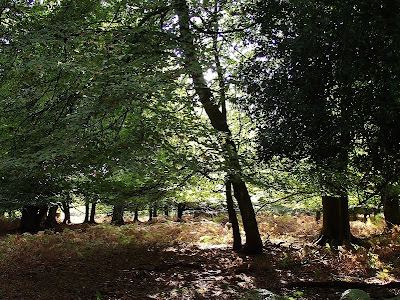 The woods are still, but for the sounds created by the occasional light breeze, just powerful enough to elicit movement amongst the canopy. A few birds high in the branches generate a gentle bird song which permeates the woodland; soothing and restful. As the ferns die back and the trees lose their summer cloths, lost vistas return and the woods open up once more. A solitary stag proudly prances out of the fading summer foliage, looks about briefly, before returning to cover; the deer are keeping a low profile, small groups or individuals hidden in clumps of shrub, only breaking cover when disturbed. The forest is winding down, preparing for the dark half of the year, as the Celts called it.
The woods are still, but for the sounds created by the occasional light breeze, just powerful enough to elicit movement amongst the canopy. A few birds high in the branches generate a gentle bird song which permeates the woodland; soothing and restful. As the ferns die back and the trees lose their summer cloths, lost vistas return and the woods open up once more. A solitary stag proudly prances out of the fading summer foliage, looks about briefly, before returning to cover; the deer are keeping a low profile, small groups or individuals hidden in clumps of shrub, only breaking cover when disturbed. The forest is winding down, preparing for the dark half of the year, as the Celts called it.Thursday 21 October 2010
The Spreading Oak
 For the first time this Autumn, Jack Frost's been abroad, a thin dusting at dawn showed testament to his presence and labours. Jack's been lurking amongst the shadows and you've been able to feel his proximity in the shaded woodland for some weeks now. By mid day though the Autumnal Sun has warmed the open heathland of Windy Stonard and Fritham Plain; Jack's been temporarily thwarted, until night fall anyway. Atop the plain stands the 'Spreading Oak', an ancient Oak tree, some 300 years old; large strong boughs protrude from a huge solid trunk. Young Holly trees cluster around its periphery, half in Sun, half in shade, the best of both worlds; their presence creating an enclosed space, a natural great hall. A wondrous and magical Leviathan of a tree.
For the first time this Autumn, Jack Frost's been abroad, a thin dusting at dawn showed testament to his presence and labours. Jack's been lurking amongst the shadows and you've been able to feel his proximity in the shaded woodland for some weeks now. By mid day though the Autumnal Sun has warmed the open heathland of Windy Stonard and Fritham Plain; Jack's been temporarily thwarted, until night fall anyway. Atop the plain stands the 'Spreading Oak', an ancient Oak tree, some 300 years old; large strong boughs protrude from a huge solid trunk. Young Holly trees cluster around its periphery, half in Sun, half in shade, the best of both worlds; their presence creating an enclosed space, a natural great hall. A wondrous and magical Leviathan of a tree. Wednesday 20 October 2010
Scabious
 Cumulus clouds float through an azure sky, the air is chill, yet the Sun still has enough strength to warm; the forest heathland still hold plenty or colour. Purple blue Devils Bit Scabious shines the brightest, as although colourful, most of the other colours are now muted ones. Winding Stonard, a flat heathland plain, lays to the south of the former Stoney Cross Airfield and was the site of dispersed airfield buildings; cleared after the sites closure in 1948, the land surface is still peppered with concrete and brick fragments, along with the occasional building foundation and utility access points. A small brown Adder ( Vipera Berus ) suns itself amongst a small mass off World War 2 debris; resembling a dried brown fern frond, flattened for maximum absorption, it enjoyed the fading heat of the weakening Sun. Startled, the 12 inch long viper hisses, strikes out, before swiftly disappearing amidst the concrete and brick voids.
Cumulus clouds float through an azure sky, the air is chill, yet the Sun still has enough strength to warm; the forest heathland still hold plenty or colour. Purple blue Devils Bit Scabious shines the brightest, as although colourful, most of the other colours are now muted ones. Winding Stonard, a flat heathland plain, lays to the south of the former Stoney Cross Airfield and was the site of dispersed airfield buildings; cleared after the sites closure in 1948, the land surface is still peppered with concrete and brick fragments, along with the occasional building foundation and utility access points. A small brown Adder ( Vipera Berus ) suns itself amongst a small mass off World War 2 debris; resembling a dried brown fern frond, flattened for maximum absorption, it enjoyed the fading heat of the weakening Sun. Startled, the 12 inch long viper hisses, strikes out, before swiftly disappearing amidst the concrete and brick voids.Tuesday 19 October 2010
Duck Hole Bog
 The forest is synonymous with wet heathland, maybe more so than the swathes of ancient woodland and 300 years of land enclosure and wooded plantation. Duck Hole Bog is one of a cluster of bogs between Wilverly plain, on the high ground and Ober Water in the wet valley below. The land here is criss crossed with fingers of narrow stream and sphagnum filled hollows, between heather covered bluffs. It's easy to see why such places in our landscape held magical significance to past societies and feared by others; the landscape is isolated, impassible in places and yet attractive and engaging; magical primeval places.
The forest is synonymous with wet heathland, maybe more so than the swathes of ancient woodland and 300 years of land enclosure and wooded plantation. Duck Hole Bog is one of a cluster of bogs between Wilverly plain, on the high ground and Ober Water in the wet valley below. The land here is criss crossed with fingers of narrow stream and sphagnum filled hollows, between heather covered bluffs. It's easy to see why such places in our landscape held magical significance to past societies and feared by others; the landscape is isolated, impassible in places and yet attractive and engaging; magical primeval places.Monday 18 October 2010
Hard Rain
 The wind's grown chill as Autumn persists, although I know once walking we'll warm up, the Sun still holds some sway. Racing across Rock Hills it creates movement amidst the browning ferns and heathers making them dance to its tune. The colours change daily now, new vistas emerge, a gift from nature, a gift that never stops giving. Entering Red Rise Shade at Rooks Bridge, the air calms, amongst the Oak trunks at least; not so in the canopy though. As the wind rustles the canopy, it rains acorns and leafs; a hard rain, a sound like a heavy shower on a tin roof. Cows graze amid the trees, the spirit of jazz amongst them. The woods are noisy, Red Rise Brook though, moves silently through the shade, graceful and smooth. The glassy surface of the brook is broken by falling acorns which land with a satisfying sploosh.
The wind's grown chill as Autumn persists, although I know once walking we'll warm up, the Sun still holds some sway. Racing across Rock Hills it creates movement amidst the browning ferns and heathers making them dance to its tune. The colours change daily now, new vistas emerge, a gift from nature, a gift that never stops giving. Entering Red Rise Shade at Rooks Bridge, the air calms, amongst the Oak trunks at least; not so in the canopy though. As the wind rustles the canopy, it rains acorns and leafs; a hard rain, a sound like a heavy shower on a tin roof. Cows graze amid the trees, the spirit of jazz amongst them. The woods are noisy, Red Rise Brook though, moves silently through the shade, graceful and smooth. The glassy surface of the brook is broken by falling acorns which land with a satisfying sploosh.Horn of plenty

The black trumpet or horn of plenty, is dark coloured, almost black and looks rather unattractive, but has a very good flavour and favoured for eating. It is a member of the Craterellus family, a generally edible fungi family, the trumpet is similar, other than colour, to the related chanterelle. They are distinguished by their lack of gill-like structures on the underside of their caps. This example was found on the bank of Red Rise Brook just above Markway bridge. Listed as 'occasional', this has certainly been the case this year.
Orange Birch Boletus
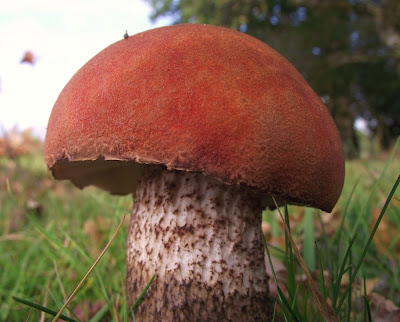 The area around Red Rise Shade is flushed with Orange Birch Boletus, found commonly in association Birch (as their name suggests) they are edible, listed in many reference books as 'good'. When cut, the flesh rapidly turns bluish before finally becoming black. Even though edible, I've never felt inclined to eat them.
The area around Red Rise Shade is flushed with Orange Birch Boletus, found commonly in association Birch (as their name suggests) they are edible, listed in many reference books as 'good'. When cut, the flesh rapidly turns bluish before finally becoming black. Even though edible, I've never felt inclined to eat them.Sunday 17 October 2010
Yew 2
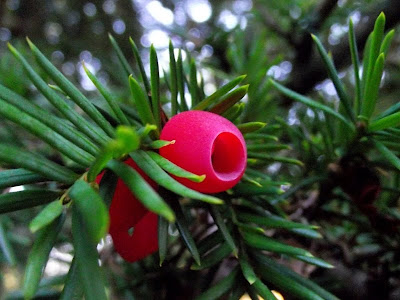 Red Rise Shade contains a large number of mature Yew trees, now fruiting the juxtaposition of the dark green evergreen leafs and bright red berries is striking. The Yew hold a high position in both folklore and bush craft, the Celts had great respect for the tree due to its association with immortality, renewal, regeneration, everlasting life, rebirth, transformation and access to the Other world and our ancestors; later faiths too adopted this reverence, hence their frequent association with churchyards. Some English Yews are thought to be over 4000 years old. In bush craft Yew wood is priced, and always has been, for its use in Longbow production, being both strong and flexible. The oldest known wooden implements is a Yew spear found at Clacton on Sea, England, dated to around 50,000 ago. Be very aware, the whole tree is poisonous - wood, bark, needles and seed. The only part which isn't is the fleshy part of the seed.
Red Rise Shade contains a large number of mature Yew trees, now fruiting the juxtaposition of the dark green evergreen leafs and bright red berries is striking. The Yew hold a high position in both folklore and bush craft, the Celts had great respect for the tree due to its association with immortality, renewal, regeneration, everlasting life, rebirth, transformation and access to the Other world and our ancestors; later faiths too adopted this reverence, hence their frequent association with churchyards. Some English Yews are thought to be over 4000 years old. In bush craft Yew wood is priced, and always has been, for its use in Longbow production, being both strong and flexible. The oldest known wooden implements is a Yew spear found at Clacton on Sea, England, dated to around 50,000 ago. Be very aware, the whole tree is poisonous - wood, bark, needles and seed. The only part which isn't is the fleshy part of the seed. Friday 15 October 2010
Thursday 14 October 2010
Honey
 Boxes have appeared around what remains of Markway enclosure, each with a coloured lid; placed just off nearby tracks their presence creates quiet a buzz around and about. You see, annually, local Bee keepers set up temporary hives throughout the forest; located in the heather rich heathland areas the Bees have an ample supply of late Summer / Autumn nectar. Mmmm honey, sweet.
Boxes have appeared around what remains of Markway enclosure, each with a coloured lid; placed just off nearby tracks their presence creates quiet a buzz around and about. You see, annually, local Bee keepers set up temporary hives throughout the forest; located in the heather rich heathland areas the Bees have an ample supply of late Summer / Autumn nectar. Mmmm honey, sweet.Tuesday 12 October 2010
Monday 11 October 2010
Sunday 10 October 2010
Old enclosure Autumn
 Even though Autumn is well entrenched in the feel, the smell and the sounds of the woodland, the Sun still shines valiantly on and although greatly diminished by increased distance, the rays which break through the browning canopy are warm, and welcomed. The Old enclosure feels like an empty cathedral, the canopy overhead rustles gently in a light breeze, loosing the first fallers of the season; dislodged leafs glide through the open spaces, before coming to rest on the woodland floor. The woods exude a sense of satisfaction, they've played their part well, the cycle keeps turning and woodland endures. The transit of the seasons, the journey of the years is nothing new for the mature leviathans inhabiting this space, the Beech, the Oak, the other smaller trees, they've seen it all before, some, hundreds of times before.
Even though Autumn is well entrenched in the feel, the smell and the sounds of the woodland, the Sun still shines valiantly on and although greatly diminished by increased distance, the rays which break through the browning canopy are warm, and welcomed. The Old enclosure feels like an empty cathedral, the canopy overhead rustles gently in a light breeze, loosing the first fallers of the season; dislodged leafs glide through the open spaces, before coming to rest on the woodland floor. The woods exude a sense of satisfaction, they've played their part well, the cycle keeps turning and woodland endures. The transit of the seasons, the journey of the years is nothing new for the mature leviathans inhabiting this space, the Beech, the Oak, the other smaller trees, they've seen it all before, some, hundreds of times before.Saturday 9 October 2010
Pale Tussock Moth Caterpillars
 Amongst the now Autumn tinted debris of summer, colourful Pale Tussock Moth Caterpillars look alien. They're found in the forest between July and October, and are fond of Oak and Birch leafs, both of which are currently abundant throughout wood and heath. It's easy to become complacent, overlooking the beauty and wonder that surrounds us, seeing creatures like this serve to remind us how far out our world is.
Amongst the now Autumn tinted debris of summer, colourful Pale Tussock Moth Caterpillars look alien. They're found in the forest between July and October, and are fond of Oak and Birch leafs, both of which are currently abundant throughout wood and heath. It's easy to become complacent, overlooking the beauty and wonder that surrounds us, seeing creatures like this serve to remind us how far out our world is.Friday 8 October 2010
Bunny
 Walkford Brook originates on the fringe of Holmsley Plain; a narrow, shallow stream, it snakes its way through the mix of woodland and farmland, which borders this part of the forest. As it nears the sea it cuts through gorge called 'Chewton Bunny'; in 1883 Cope notes: 'that 'bunny' is a specialized term of the New Forest area, of unknown origin, for a narrow rift or valley, what is called on Isle of Wight or in Bournemouth a 'chine', the sides of the 'Bunny' are densely covered in mature trees and shrubs, a lush damp environment of fern and other shade loving plants.
Walkford Brook originates on the fringe of Holmsley Plain; a narrow, shallow stream, it snakes its way through the mix of woodland and farmland, which borders this part of the forest. As it nears the sea it cuts through gorge called 'Chewton Bunny'; in 1883 Cope notes: 'that 'bunny' is a specialized term of the New Forest area, of unknown origin, for a narrow rift or valley, what is called on Isle of Wight or in Bournemouth a 'chine', the sides of the 'Bunny' are densely covered in mature trees and shrubs, a lush damp environment of fern and other shade loving plants.Wednesday 6 October 2010
Red Rise Autumn
 It's the same in regards to every season, but the forest is beautiful this time of year; the colour range, the purple of the heather, the browns and oranges through to light greens of the retreating ferns, the hint of change amongst the canopy. The air is cooler and the nights are decidedly chill. Since the initial burst of Cep action, the forest has been less productive, for several days now few mushrooms have been visible and those that have been have been mauled and chewed; the cold and dry. I hope we're experiencing a hiatus in the shrooming season rather than its truncation.
It's the same in regards to every season, but the forest is beautiful this time of year; the colour range, the purple of the heather, the browns and oranges through to light greens of the retreating ferns, the hint of change amongst the canopy. The air is cooler and the nights are decidedly chill. Since the initial burst of Cep action, the forest has been less productive, for several days now few mushrooms have been visible and those that have been have been mauled and chewed; the cold and dry. I hope we're experiencing a hiatus in the shrooming season rather than its truncation. Psilocybin
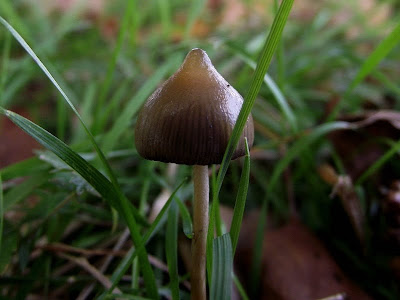 Psilocybe semilanceata or liberty cap is a psychedelic mushroom that contains the psychoactive compound psilocybin. They grows in grassy meadows, grassy heath and in the most unexpected sites; they have a distinctive conical cap with a small nipple on the top, often described as a pixies hat. They are yellow to brown in colour, almost transparent when young and wet, then they fade to a lighter buff color as they mature. Their stems tend to be long and the same colour or slightly lighter than the cap. The psychoactive content and relative safety, when taken in small to moderate doses, makes them a popular hallucinogenic, still illegal though.
Psilocybe semilanceata or liberty cap is a psychedelic mushroom that contains the psychoactive compound psilocybin. They grows in grassy meadows, grassy heath and in the most unexpected sites; they have a distinctive conical cap with a small nipple on the top, often described as a pixies hat. They are yellow to brown in colour, almost transparent when young and wet, then they fade to a lighter buff color as they mature. Their stems tend to be long and the same colour or slightly lighter than the cap. The psychoactive content and relative safety, when taken in small to moderate doses, makes them a popular hallucinogenic, still illegal though. Tuesday 5 October 2010
Monday 4 October 2010
Sunday 3 October 2010
Saturday 2 October 2010
Chestnuts
 We came across some fallen Chestnuts on one of the tracks through Burley New Enclosure. Some nuts had been thrown clear of their cases, whilst most remained encased in their spiky armour. The Chestnuts so far this season have been of good size; the nuts collected today are still pale and may have fallen early due to the strong winds racing through the trees, although they soon become brown in the bowl.
We came across some fallen Chestnuts on one of the tracks through Burley New Enclosure. Some nuts had been thrown clear of their cases, whilst most remained encased in their spiky armour. The Chestnuts so far this season have been of good size; the nuts collected today are still pale and may have fallen early due to the strong winds racing through the trees, although they soon become brown in the bowl.
Subscribe to:
Posts (Atom)
















